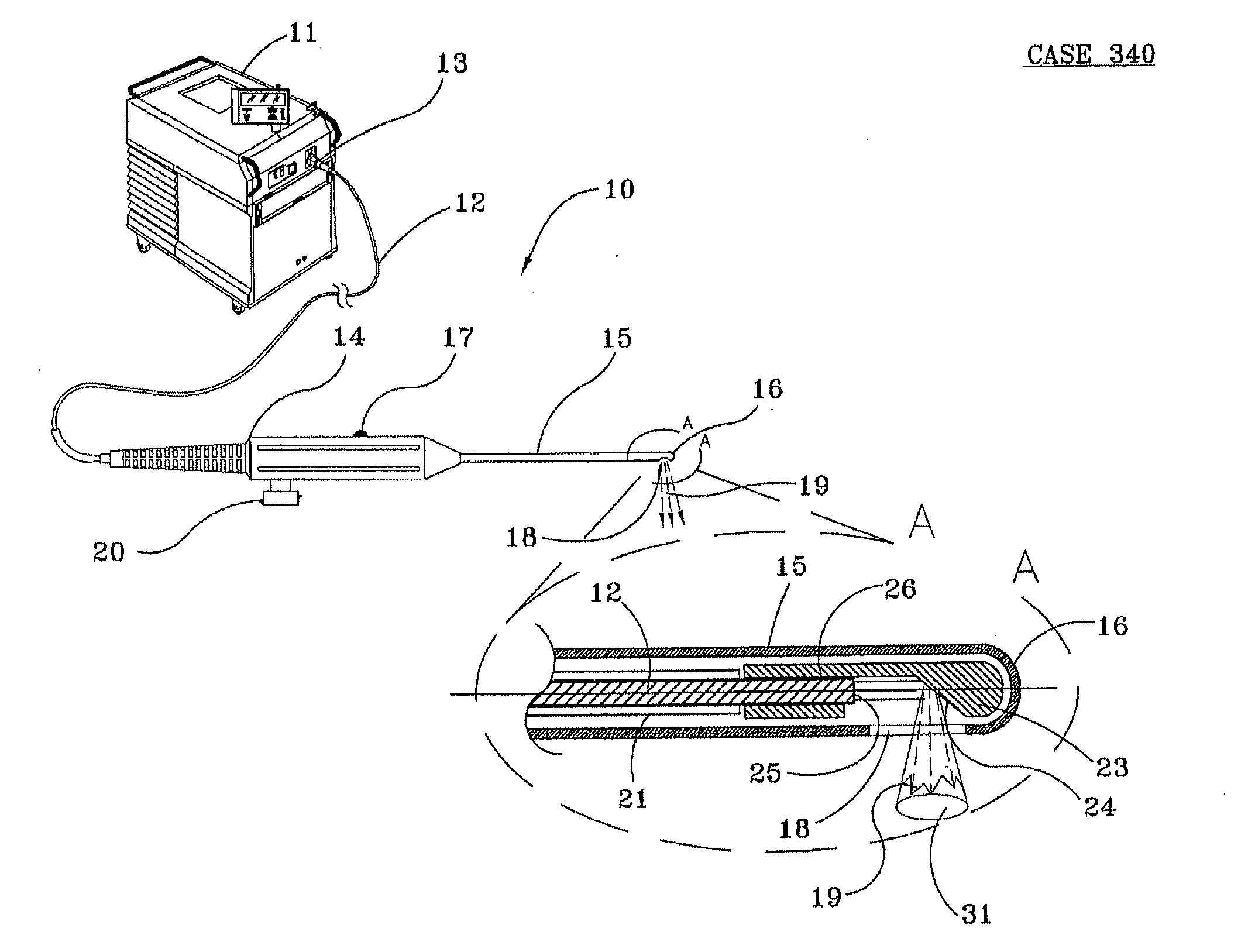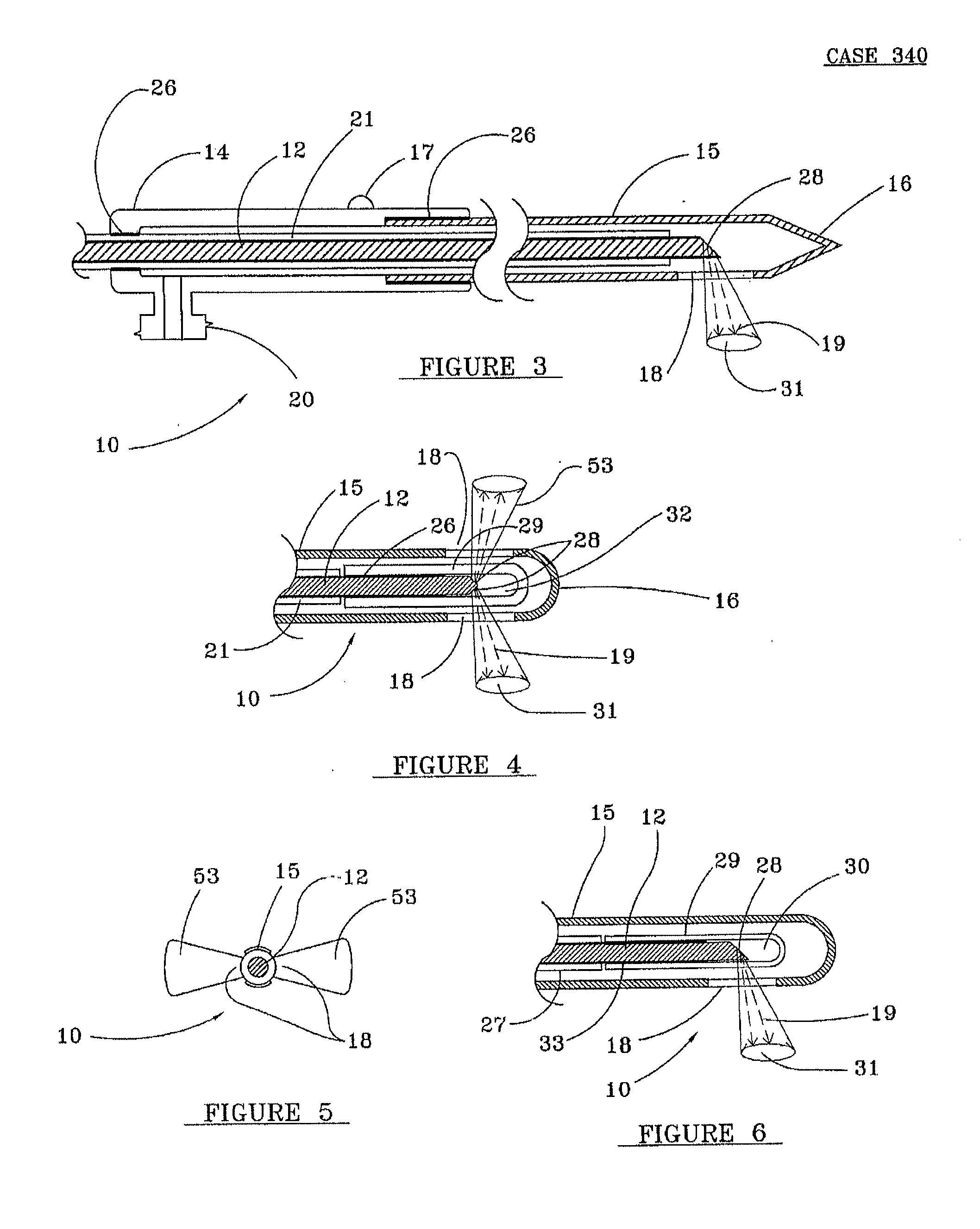Devices for effective and uniform denervation of nerves and unique methods of use thereof
a technology of denervation and nerves, applied in the field of devices for effective and uniform denervation of nerves, can solve the problems of high cost, high cost, and high cost of healthcare system, and achieve the effect of avoiding excessive thermal damage to the target nerv
- Summary
- Abstract
- Description
- Claims
- Application Information
AI Technical Summary
Benefits of technology
Problems solved by technology
Method used
Image
Examples
first embodiment
[0174]side firing device 10 of the present invention is illustrated in FIG. 1. In this embodiment, device 10 is comprised of laser energy source 11 and optical fiber 12. Connector 13 optically couples optical fiber 12 to laser energy source 11. Optical fiber 12 is fixedly and sealingly attached within the proximal end of handpiece 14 by adhesive 26, as known in the art, and extends through a hollow, longitudinal, passageway (not separately shown) in handpiece 14 and is in fluid communication with hollow metal or plastic cannula 15, preferably of medical grade stainless steel, whose proximal end is fixedly attached by adhesive 26 within the distal end of handpiece 14. Cannula 15 can be rigid, semi-rigid, flexible, or pliant.
[0175]The distal end 16 of cannula 15, as shown in FIG. 1, is rounded. Distal end 16 of cannula 15 may also be blunt, sharp, double-bevel needle-shaped, trocar shaped or of any other desired shape, as known in the art. Using a needle-like or sharp-ended cannula wi...
second embodiment
[0186]side firing device 10 of the present invention is shown in FIG. 2. In this embodiment, distal end 16 of hollow cannula 15 is shaped like the distal end of a double beveled syringe needle, which cuts rather than puncturing or making a hole through the skin, hastening healing and reducing bleeding and the risk of an infection. To prevent tissue from lodging in the opening at distal end 16 of cannula 15, plug 27 of adhesive 26 or other material, preferably heat resistant to any stray laser energy, may be used to fill distal end 16 of cannula 15.
[0187]Distal end 16 of hollow cannula 15 can also be blunt, round, conical or any other desired shape, as the use of a sharp or needle-like device within a patient requires imaging during its use and great care by the surgeon.
[0188]Buffer coating 21 and any optional polymer cladding have been removed from the distal end portion of optical fiber 12, and the distal end of optical fiber 12 has been ground and polished into beveled, distal end...
third embodiment
[0192]FIG. 3 illustrates side firing device 10 of the present invention. In this embodiment, no capillary tube 29 is utilized to sealingly encase the beveled, distal end surface 28 of optical fiber 12. As a result, no air pocket is created opposite beveled, distal end surface 28 of optical fiber 12.
[0193]Laser energy at wavelengths of 1400 to 1500 nm and 1800 to 11,000 nm is highly absorbed by aqueous liquids, such as sterile saline or water, which are commonly used as an irrigation fluid in endoscopic procedures. If ten watts or more of laser power at these wavelengths is transmitted through optical fiber 12, such wavelengths of laser energy cause a steam and / or gas bubble to form, with each pulse of laser energy, opposite beveled, distal end surface 28 of optical fiber 12, from the vaporization of the aqueous irrigation liquid, blood, other body fluids and / or tissue.
[0194]The refractive index of the steam and / or gas bubble opposite beveled, distal end surface 28 of optical fiber 1...
PUM
 Login to View More
Login to View More Abstract
Description
Claims
Application Information
 Login to View More
Login to View More - R&D
- Intellectual Property
- Life Sciences
- Materials
- Tech Scout
- Unparalleled Data Quality
- Higher Quality Content
- 60% Fewer Hallucinations
Browse by: Latest US Patents, China's latest patents, Technical Efficacy Thesaurus, Application Domain, Technology Topic, Popular Technical Reports.
© 2025 PatSnap. All rights reserved.Legal|Privacy policy|Modern Slavery Act Transparency Statement|Sitemap|About US| Contact US: help@patsnap.com



